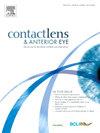Contact lenses for visual rehabilitation in post-keratoplasty eyes: A systematic review
IF 4.1
3区 医学
Q1 OPHTHALMOLOGY
引用次数: 0
Abstract
Purpose
To evaluate the role of contact lenses (CLs) in visual rehabilitation following keratoplasty.
Methods
Four databases, including PubMed, Scopus, Web of Science, and Embase were systematically searched for studies published between January 2010 and July 2023. Visual outcomes, daily wearing duration, subjective comfort, rate and etiology of CL discontinuation, corneal endothelial cell density, central corneal thickness, and complications were extracted.
Results
This review included thirteen case series and two chart reviews, analyzing a total of 464 eyes, of which 97% underwent penetrating keratoplasty. Scleral CLs were the most frequently fitted lens (285 eyes, 61%). All studies reported a significant improvement in visual acuity with CL correction. Most post-keratoplasty patients could wear CLs comfortably for 8 to 12 h/day. The rate of CL dropout ranged from 0% to 39%, mainly due to CL intolerance, discomfort, and graft rejection. Corneal graft rejection (18 eyes), conjunctival hyperemia (8 eyes), corneal epithelial trauma (5 eyes), graft edema (4 eyes), and microbial keratitis (3 eyes) were the most frequently reported complications.
Conclusion
CLs are effective for improving visual acuity following keratoplasty, with minor complications depending on the type of CL.
角膜移植术后隐形眼镜的视力康复:一项系统综述。
目的:评价隐形眼镜在角膜移植术后视力康复中的作用。方法:系统检索PubMed、Scopus、Web of Science和Embase 4个数据库,检索2010年1月至2023年7月间发表的研究。提取视力结果、日常佩戴时间、主观舒适度、CL停药率和原因、角膜内皮细胞密度、角膜中央厚度和并发症。结果:本综述包括13个病例系列和2个图表回顾,共分析了464只眼睛,其中97%进行了穿透性角膜移植术。巩膜细胞是最常见的晶状体(285眼,61%)。所有的研究都报告了CL矫正后视力的显著改善。大多数角膜移植术后患者可以舒适地佩戴CLs 8 - 12小时/天。CL放弃率从0%到39%不等,主要是由于CL不耐受、不适和移植物排斥。最常见的并发症是角膜移植排斥反应(18眼)、结膜充血(8眼)、角膜上皮损伤(5眼)、移植物水肿(4眼)和微生物角膜炎(3眼)。结论:CL可有效改善角膜移植术后的视力,且随CL类型不同并发症较少。
本文章由计算机程序翻译,如有差异,请以英文原文为准。
求助全文
约1分钟内获得全文
求助全文
来源期刊

Contact Lens & Anterior Eye
OPHTHALMOLOGY-
CiteScore
7.60
自引率
18.80%
发文量
198
审稿时长
55 days
期刊介绍:
Contact Lens & Anterior Eye is a research-based journal covering all aspects of contact lens theory and practice, including original articles on invention and innovations, as well as the regular features of: Case Reports; Literary Reviews; Editorials; Instrumentation and Techniques and Dates of Professional Meetings.
 求助内容:
求助内容: 应助结果提醒方式:
应助结果提醒方式:


